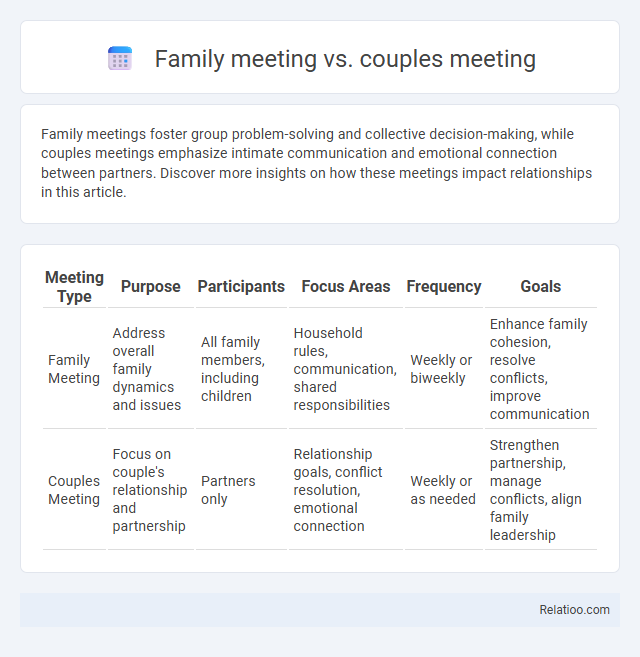Family meetings foster group problem-solving and collective decision-making, while couples meetings emphasize intimate communication and emotional connection between partners. Discover more insights on how these meetings impact relationships in this article.
Table of Comparison
| Meeting Type | Purpose | Participants | Focus Areas | Frequency | Goals |
|---|---|---|---|---|---|
| Family Meeting | Address overall family dynamics and issues | All family members, including children | Household rules, communication, shared responsibilities | Weekly or biweekly | Enhance family cohesion, resolve conflicts, improve communication |
| Couples Meeting | Focus on couple's relationship and partnership | Partners only | Relationship goals, conflict resolution, emotional connection | Weekly or as needed | Strengthen partnership, manage conflicts, align family leadership |
Understanding the Purpose: Family Meeting vs Couples Meeting
Family meetings focus on fostering open communication and mutual support among all family members, addressing collective concerns and planning together. Couples meetings concentrate on enhancing intimacy, resolving conflicts, and strengthening the partnership between two individuals. Understanding the distinct purpose of family meetings versus couples meetings helps tailor discussions to address broader family dynamics or intimate relational issues effectively.
Key Differences in Structure and Attendees
Family meetings typically involve multiple generations and focus on broad family issues, inheritance, and collective decision-making, whereas couples meetings are intimate and centered on relationship dynamics and joint goals. Family meetings often include parents, children, and extended relatives, while couples meetings are restricted to partners only. Your choice between these formats should consider the scale of discussion and the specific participants required to address your agenda effectively.
Common Topics Discussed in Family Meetings
Family meetings typically address household responsibilities, budgeting, and schedules to ensure smooth family functioning, while couples meetings often focus on relationship dynamics, communication, and future planning. Common topics discussed in family meetings include conflict resolution, chore assignments, and upcoming events, fostering cooperation among all members. Unlike couples meetings, which center on intimate relationship goals, family meetings engage multiple generations in shared problem-solving and decision-making.
Focus Areas in Couples Meetings
Couples meetings primarily focus on enhancing emotional connection, improving communication, and resolving interpersonal conflicts between partners. These sessions address intimacy, shared goals, and mutual support, creating a foundation for relationship growth and stability. Your engagement in couples meetings facilitates deeper understanding and strengthens commitment, differentiating these gatherings from broader family meetings that include multiple members and dynamics.
Benefits of Regular Family Meetings
Regular family meetings enhance communication, promote problem-solving, and strengthen emotional bonds among all members by providing a structured space for open dialogue. Compared to couples meetings that center on relationship dynamics, family meetings address collective issues and foster inclusivity, making your household more cohesive and resilient. These gatherings support shared decision-making, conflict resolution, and the development of mutual respect across generations.
Advantages of Holding Couples Meetings
Couples meetings foster direct communication and emotional intimacy, enabling partners to address relationship issues and align goals effectively. These meetings promote mutual understanding and conflict resolution by creating a focused environment tailored to the couple's specific needs. Unlike family meetings, which involve multiple perspectives and can dilute individual concerns, couples meetings prioritize the unique dynamic between partners, strengthening their bond and cooperation.
Communication Strategies for Both Meeting Types
Effective communication strategies for family meetings and couples meetings differ in focus and approach, yet both require active listening and emotional validation to ensure productive dialogue. In family meetings, clear role definitions and conflict resolution techniques help manage diverse perspectives and maintain harmony, while couples meetings benefit from focused empathy and collaborative problem-solving to strengthen intimacy. By tailoring your communication approach to each meeting type, you enhance understanding and foster stronger relationships.
Setting Guidelines for Effective Meetings
Setting guidelines for effective family meetings involves creating clear communication rules, establishing shared goals, and ensuring every member feels heard, which fosters unity and problem-solving. Couples meetings require a focus on emotional openness, mutual respect, and establishing boundaries to resolve conflicts and deepen intimacy. Your approach to family meetings versus couples meetings should prioritize tailored strategies that address the unique dynamics and objectives of each group, ensuring productive and harmonious discussions.
Challenges and Solutions in Family and Couples Meetings
Family meetings often face challenges like communication barriers and conflicting priorities among multiple members, requiring structured agendas and active listening to ensure everyone's voice is heard. Couples meetings encounter emotional intensity and personal differences, making empathy, clear boundaries, and conflict resolution techniques essential for productive dialogue. Your ability to implement tailored solutions based on these distinct dynamics helps foster understanding and cooperation in both family and couples meetings.
When to Choose a Family Meeting Over a Couples Meeting
Choose a family meeting over a couples meeting when issues involve multiple family members, such as shared responsibilities, parenting challenges, or collective decision-making. Family meetings facilitate open communication among all members, ensuring diverse perspectives are addressed and consensus is reached. Couples meetings are more effective for resolving intimate relationship conflicts or improving partner communication without external influences.

Infographic: Family meeting vs Couples meeting
 relatioo.com
relatioo.com